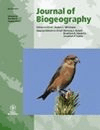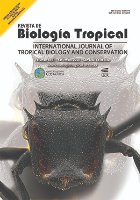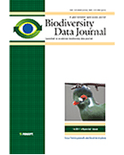
Biodiversity Informatics
Scope & Guideline
Bridging the gap between biodiversity and technology for impactful research.
Introduction
Aims and Scopes
- Ecological Niche Modeling:
The journal emphasizes the development and application of ecological niche models to predict species distributions and ecological niches, utilizing various data types such as presence-absence data. - Data Management and Usability in Biodiversity Research:
A significant focus is placed on best practices for managing biodiversity data, including guidelines for citizen science projects and the usability of data systems for biological collections. - Species Distribution and Geographic Range Analysis:
Research on methods and tools for analyzing species distribution patterns and geographic ranges is a core area, including the use of R packages for data exploration. - Integration of Genetic Diversity in Biodiversity Frameworks:
The journal supports studies that connect genetic diversity indicators to broader biodiversity frameworks, highlighting the importance of genetic information in conservation strategies. - Interdisciplinary Approaches to Biodiversity Data:
Biodiversity Informatics encourages interdisciplinary research that combines ecological, genetic, and computational methodologies to provide comprehensive insights into biodiversity.
Trending and Emerging
- Advancements in Computational Tools for Biodiversity Research:
There is a growing trend towards the development and application of computational tools, such as R packages for ecological niche modeling and species distribution analysis, reflecting the increasing reliance on technology in biodiversity studies. - Focus on Genetic Diversity Indicators:
Recent papers emphasize the importance of genetic diversity indicators within biodiversity frameworks, showcasing a shift towards incorporating genetic data as critical components of biodiversity assessments. - Citizen Science and Community Engagement:
The rise in publications addressing data management practices in citizen science indicates a trend towards recognizing the value of public participation in biodiversity monitoring and data collection. - Integration of Large-Scale Data Mining Techniques:
The use of big GIS-data mining techniques to predict species occurrences signifies an emerging focus on leveraging large datasets for robust biodiversity inference, which is increasingly relevant in addressing ecological questions. - Geographic Information Systems (GIS) Applications:
The application of GIS in visualizing species richness and site similarity has become a prominent theme, reflecting the importance of spatial analysis in biodiversity research.
Declining or Waning
- Historical Data Analysis:
There seems to be a decline in the publication of papers focused on historical biodiversity data analysis, as recent titles favor contemporary modeling and data management practices. - General Biodiversity Surveys without Specific Focus:
Research papers that report general biodiversity surveys without a specific methodological or analytical focus are becoming less common, as the journal shifts towards more targeted studies with clear applications. - Traditional Field Methods in Isolation:
There is a noticeable reduction in papers that discuss traditional field methods in isolation, suggesting a move towards integrating field data with computational and modeling approaches.
Similar Journals

JOURNAL OF BIOGEOGRAPHY
Exploring the Intersections of Ecology and GeographyJOURNAL OF BIOGEOGRAPHY, published by Wiley, stands as a premier multidisciplinary platform for the publication of high-quality research in the fields of biogeography and ecology. With an impressive Q1 ranking in both Ecology and Ecology, Evolution, Behavior and Systematics categories for 2023, this journal is recognized for its significant contribution to understanding ecological patterns and processes across geographic spaces. The journal, which has been in circulation since 1948 with a continuous production from 1979 to 2024, features rigorously peer-reviewed articles, critical reviews, and essential data that illuminate the dynamic interactions between organisms and their environments. While this journal does not currently offer open access options, it remains a valuable resource for researchers, professionals, and students seeking to explore the latest discoveries and theoretical advances in biogeography. With impressive Scopus rankings, including a 73rd position out of 721 in Agricultural and Biological Sciences and a 53rd position out of 461 in Environmental Science, the JOURNAL OF BIOGEOGRAPHY is indispensable for those aiming to advance their understanding of ecological frameworks and biodiversity conservation.

NeoBiota
Championing innovative research in ecology and conservation.NeoBiota, published by Pensoft Publishers in Bulgaria, is a preeminent Open Access journal dedicated to advancing knowledge in biodiversity, ecology, and conservation science. Since its inception in 2011, it has established itself as a pivotal platform for scholarly discourse, maintaining an impressive impact factor that places it in the Q1 quartile across multiple categories, including Animal Science and Zoology, Aquatic Science, and Ecology. With its articles indexed in leading databases and Scopus rankings that affirm its standing (e.g., rank #12 in Animal Science and Zoology), NeoBiota serves as a vital resource for researchers, professionals, and students. The journal emphasizes the synthesis of ecological modeling and evolutionary processes, fostering interdisciplinary collaboration and promoting rigorous research methodologies. Authors are encouraged to contribute their insights on biodiversity metrics, ecosystem dynamics, and the ecological implications of anthropogenic changes, making NeoBiota essential for anyone invested in the future of our planet's ecosystems. Discover the treasures of ecological scholarship through this influential journal.

REVISTA DE BIOLOGIA TROPICAL
Connecting researchers to the pulse of tropical biology.REVISTA DE BIOLOGIA TROPICAL is a prominent scholarly journal published by the Universidad de Costa Rica that serves as a vital platform for research in the realms of agricultural and biological sciences. Established in 1969, the journal has evolved into a crucial resource, contributing significantly to the understanding of tropical ecosystems and biodiversity. With its current classification in the Q2 quartile for Agricultural and Biological Sciences, it ranks #109 out of 221 journals in its category, reflecting its esteemed position within the academic community. Although it operates under traditional access guidelines, the journal remains committed to disseminating high-quality research that informs conservation efforts and sustainable practices in tropical biology. The journal's diverse scope encompasses a wide range of topics, ensuring relevance for professionals, researchers, and students dedicated to enhancing knowledge and innovation in the biological sciences. As the journal progresses towards 2024, it continues to invite contributions that advance scientific discourse and foster collaboration within the field.

BMC Genomic Data
Advancing the frontier of genomic research.BMC Genomic Data is a pioneering open-access journal dedicated to the dynamic field of genomics and health informatics, published by BMC, a renowned leader in scientific publishing based in the United Kingdom. Since its inception in 2021, the journal has established itself as a valuable resource for researchers, professionals, and students, providing a platform for the dissemination of high-quality genomic data research. With a focus on advancing knowledge in both genetics and health informatics, BMC Genomic Data holds a Q3 ranking in both categories as of 2023, indicating its growing influence and relevance in the scientific community. The journal has an impressive entry into the competitive landscape of academia, ranking #55 in the Medicine & Health Informatics category and #173 in Biochemistry, Genetics and Molecular Biology, reflecting its commitment to publishing impactful research. By offering an open-access model, researchers are encouraged to disseminate their findings widely, contributing to the ongoing dialogue in genomics. For those looking to stay at the forefront of genomic research and data analysis, BMC Genomic Data is an essential resource that promotes innovation and collaboration across disciplines.

ANIMAL BIODIVERSITY AND CONSERVATION
Championing biodiversity for generations to come.ANIMAL BIODIVERSITY AND CONSERVATION is a distinguished open-access journal dedicated to advancing the knowledge of animal biodiversity and conservation practices. Published by the esteemed MUSEU DE CIENCIES NATURALS-ZOOLOGIA in Spain, it provides a platform for researchers and professionals in the fields of Animal Science and Nature Conservation. With its ISSN of 1578-665X and E-ISSN 2014-928X, the journal has been committed to open access publication since 2001, ensuring that valuable research is easily accessible to a global audience. As of 2023, it holds an impressive Q2 ranking in both Animal Science and Zoology and Nature and Landscape Conservation, reflecting its impact and relevance in the scholarly community. The journal covers a broad scope of topics, contributing vital insights and fostering discussions that support the conservation of biodiversity. With key Scopus rankings revealing its standing among the top journals in its field, ANIMAL BIODIVERSITY AND CONSERVATION continues to be an essential resource for researchers, conservationists, and students dedicated to understanding and preserving the rich tapestry of life on our planet.

ECOGRAPHY
Innovating Conservation Through Cutting-Edge ResearchECOGRAPHY, published by WILEY, stands at the forefront of ecological and evolutionary research, with an impressive Impact Factor reflecting its esteemed position in the Q1 category of Ecology, Evolution, Behavior, and Systematics. Operating since 1978 and transitioning to a fully Open Access model in 2020, the journal is dedicated to disseminating high-quality research that influences conservation practices and enhances our understanding of ecological dynamics. With an ISSN of 0906-7590 and an E-ISSN of 1600-0587, ECOGRAPHY has garnered a remarkable placement in Scopus rankings, being in the top 4% of its category, achieving an impressive rank of #27 out of 721 in Agricultural and Biological Sciences. Academics from around the globe benefit from the research published in this journal, which seeks to engage and inspire further exploration of ecological systems. For inquiries, ECOGRAPHY can be reached at their UK address: 111 River St, Hoboken 07030-5774, NJ.

Biodiversity Data Journal
Connecting data and conservation for a healthier ecosystem.Biodiversity Data Journal, published by PENSOFT PUBLISHERS, is a leading open-access platform that has been facilitating the dissemination of scientific knowledge since its inception in 2013. With a focus on enriching the fields of Agricultural and Biological Sciences, Animal Science and Zoology, Ecology, and Plant Science, this journal plays a pivotal role in promoting research outputs related to biodiversity, encompassing ecological data, species inventories, and conservation strategies. It has achieved commendable rankings in various categories, notably securing a Q2 rating in several key areas, indicating its growing influence within the academic community. The journal’s contribution to advancing the understanding of biodiversity is further enhanced by its commitment to open access, ensuring that vital research findings are widely accessible to researchers, professionals, and students worldwide. By publishing comprehensive datasets and innovative research, the Biodiversity Data Journal remains an essential resource for those looking to stay at the forefront of biodiversity science and environmental stewardship.

Methods in Ecology and Evolution
Connecting disciplines to unravel ecological complexities.Methods in Ecology and Evolution, published by WILEY, is a leading journal in the fields of ecology, evolution, and environmental science, with an impact factor that reflects its high-quality research contributions. Since its inception in 2011, this journal has become a cornerstone for researchers and practitioners, offering a platform for innovative methodologies and transformative insights that advance our understanding of ecological and evolutionary processes. With a prestigious Q1 ranking in both Ecological Modeling and Ecology, Evolution, Behavior and Systematics, the journal stands out among its peers, being ranked #28 out of 721 in the Agricultural and Biological Sciences category and #4 out of 41 in Environmental Science. The journal's comprehensive scope encourages interdisciplinary collaboration, making it an essential resource for anyone working at the intersection of ecological research and data modeling. Although it does not offer open access, the wealth of knowledge within its pages is invaluable for developing effective conservation strategies and understanding complex biological systems.

Nature Conservation Research
Advancing conservation science for a sustainable future.Nature Conservation Research is a prominent open-access journal that has been dedicated to advancing the field of conservation science since its inception in 2016. Published by the SARANSK FOND PODDERZKI & RAZVITIA ZAPOVEDNYH in the Russian Federation, this journal serves as a vital platform for researchers, professionals, and students alike, providing critical insights into ecological and environmental issues. With an impressive impact factor and ranked in the second quartile across multiple categories—including Agricultural and Biological Sciences, Earth and Planetary Sciences, Ecology, and Nature and Landscape Conservation—Nature Conservation Research stands at the forefront of impactful scientific discourse. The journal not only aims to disseminate high-quality research findings but also seeks to foster collaboration and innovation in conservation practices globally. By ensuring open access to its content, it promotes widespread dissemination of knowledge, crucial in the fight against biodiversity loss and environmental degradation. Researchers and practitioners contributing to the journal will find themselves at the convergence of science and conservation efforts, paving the way for sustainable ecosystem management.

BRITTONIA
Illuminating Plant Biology for a Greener TomorrowBRITTONIA, published by Springer, stands as a reputable journal dedicated to advancing the fields of botany and plant sciences. With a storied history dating back to 1931, this journal has evolved to embrace contemporary research spanning various aspects of plant biology, ecology, and systematics. Focusing on a comprehensive analysis of both ecological interactions and plant systematics, BRITTONIA plays a crucial role in disseminating knowledge among researchers and professionals committed to understanding plant life and its environmental contexts. Despite its open access status being currently unavailable, the journal ensures wide accessibility through institutional subscriptions. In the latest rankings, it proudly holds a Q2 category in Plant Science and a Q3 category in Ecology, Evolution, Behavior, and Systematics, indicating its growing influence and academic rigor. Researchers and students alike will find BRITTONIA an essential resource for the latest findings and discussions in plant sciences.